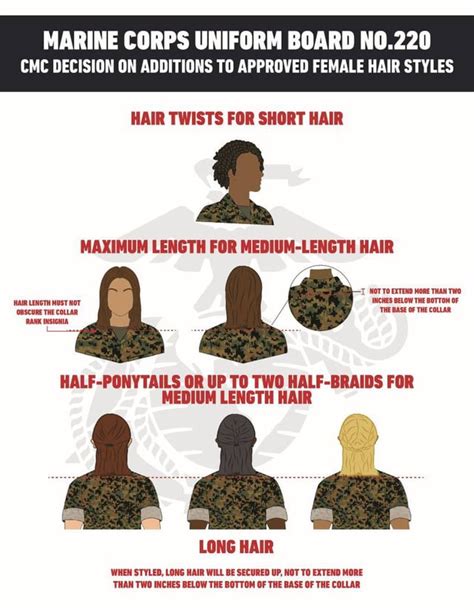
The Marine Corps’ grooming standards are under scrutiny, with critics alleging the policy disproportionately affects Black male Marines due to restrictions on hairstyles common within the Black community. Advocates argue that the current regulations, particularly those concerning hair length and bulk, effectively bar Black men from wearing natural hairstyles such as twists, braids, and locs, pushing them to conform to a predominantly Eurocentric standard of appearance.
The debate centers on whether the policy upholds professionalism and unit cohesion, as the Marine Corps asserts, or whether it perpetuates racial bias and undermines diversity within the ranks. Critics point to similar policy changes in other branches of the military and in civilian workplaces as evidence that grooming standards can be inclusive and respectful of diverse hair textures and styles. Concerns have escalated, prompting calls for the Marine Corps to re-evaluate its policy to ensure equitable treatment for all Marines, regardless of race.
The current Marine Corps grooming policy states specific requirements for hair, including length, bulk, and style. Male Marines are required to have tapered haircuts, with hair closely trimmed on the sides and back of the head. The policy restricts hair from exceeding a certain length and bulk, and it prohibits certain hairstyles, including dreadlocks, braids wider than a certain diameter, and twists that do not conform to specific size and shape guidelines. These restrictions, critics argue, disproportionately affect Black men who often have hair textures and growth patterns that make it difficult to comply with these standards without resorting to chemically altering their hair or cutting it very short.
Supporters of the current policy argue that uniformity in appearance is essential for maintaining discipline, esprit de corps, and operational effectiveness. They contend that strict grooming standards promote a sense of unity and professionalism, which are critical for military cohesion. Furthermore, they assert that the policy is applied equally to all Marines, regardless of race, and that any perceived disparities in impact are unintentional. The Marine Corps has stated that the policy is designed to ensure that all Marines maintain a neat and professional appearance while in uniform, and that it is regularly reviewed and updated to reflect evolving standards.
However, critics argue that the policy’s emphasis on neatness and uniformity reflects a bias toward Eurocentric hair textures and styles, effectively forcing Black men to conform to a standard that is not naturally suited to their hair. They point to the fact that many Black men have hair that is naturally curly, kinky, or coily, and that these textures often require specialized care and styling to maintain a healthy and professional appearance. The restrictions on length and bulk, they argue, make it difficult for Black men to wear their hair in its natural state without violating the policy.
The debate over the Marine Corps’ grooming standards is not new. For years, advocates for racial equality have argued that military grooming policies often reflect systemic biases that disadvantage Black service members. In recent years, other branches of the military have taken steps to address these concerns by updating their grooming policies to be more inclusive of diverse hair textures and styles. The Army, for example, has revised its regulations to allow soldiers to wear braids, locs, and twists, provided that they meet certain size and appearance requirements. The Air Force has also updated its grooming policy to allow for a wider range of hairstyles, including braids and locs.
These changes in other branches of the military have put pressure on the Marine Corps to reconsider its own grooming policy. Critics argue that the Marine Corps is lagging behind its sister services in recognizing and addressing the unique needs and concerns of Black service members. They contend that the Marine Corps has a responsibility to ensure that its grooming standards are fair and equitable for all Marines, regardless of race or ethnicity.
The issue has gained traction on social media, with many current and former Marines sharing their experiences and perspectives on the grooming policy. Some Black Marines have spoken out about the challenges they face in complying with the policy, and the emotional toll it takes on them to constantly alter their hair to meet the required standards. Others have expressed frustration that the policy seems to prioritize uniformity over diversity, and that it sends a message that Black men are not fully welcome or accepted in the Marine Corps.
“The issue is not about wanting to look unprofessional,” one former Marine wrote on Twitter. “It’s about wanting to be able to wear my hair in its natural state without being penalized for it. I served my country with pride, and I deserve to be treated with respect, regardless of my hairstyle.”
The debate over the Marine Corps’ grooming standards also raises broader questions about diversity and inclusion in the military. The Marine Corps, like other branches of the military, has made efforts to increase diversity in its ranks. However, critics argue that these efforts are undermined by policies that perpetuate systemic biases and create barriers to advancement for minority service members. They contend that the Marine Corps needs to do more to create a culture of inclusion and respect, where all Marines feel valued and supported, regardless of their race, ethnicity, or cultural background.
“Diversity is not just about numbers,” said a diversity and inclusion advocate. “It’s about creating an environment where people from all backgrounds feel like they belong and have the opportunity to succeed. That means addressing systemic biases and creating policies that are fair and equitable for everyone.”
The Marine Corps has acknowledged the concerns raised by critics and has stated that it is reviewing its grooming policy to ensure that it is fair and equitable for all Marines. However, the Marine Corps has also emphasized the importance of maintaining discipline and uniformity in appearance, and it has not indicated that it is planning to make any significant changes to its current policy.
The debate over the Marine Corps’ grooming standards is likely to continue in the coming months. Advocates for racial equality are expected to continue to press the Marine Corps to update its policy to be more inclusive of diverse hair textures and styles. They argue that such changes are necessary to ensure that the Marine Corps is a truly diverse and inclusive organization, where all Marines feel valued and respected.
FAQ: Marine Corps Grooming Policy Controversy
1. What is the main controversy surrounding the Marine Corps’ hair policy?
The primary issue revolves around allegations that the Marine Corps’ grooming standards disproportionately affect Black male Marines. Critics argue that the restrictions on hair length, bulk, and allowable styles effectively prohibit Black men from wearing natural hairstyles common within the Black community, such as twists, braids, and locs, forcing them to conform to Eurocentric standards.
2. What are the specific restrictions within the Marine Corps grooming policy that are being questioned?
The specific restrictions include limitations on hair length and bulk, requirements for tapered haircuts, and prohibitions on certain hairstyles such as dreadlocks, braids wider than a certain diameter, and twists that do not conform to specific size and shape guidelines. These requirements, critics argue, make it difficult for Black men to wear their hair in its natural state without violating the policy or resorting to chemical treatments.
3. What are the Marine Corps’ arguments in support of the current grooming policy?
The Marine Corps maintains that the policy is essential for maintaining discipline, esprit de corps, and operational effectiveness. They assert that uniformity in appearance promotes a sense of unity and professionalism, which are critical for military cohesion. Additionally, they state that the policy is applied equally to all Marines, regardless of race, and any perceived disparities in impact are unintentional. The policy ensures all Marines maintain a neat and professional appearance while in uniform, and it is regularly reviewed and updated.
4. How have other branches of the U.S. military addressed similar concerns about grooming policies?
Other branches of the military, such as the Army and the Air Force, have revised their grooming policies to be more inclusive of diverse hair textures and styles. The Army, for example, allows soldiers to wear braids, locs, and twists, provided they meet certain size and appearance requirements. These changes have put pressure on the Marine Corps to reconsider its own grooming policy.
5. What are the potential consequences of the Marine Corps not addressing these concerns about its grooming policy?
If the Marine Corps fails to address these concerns, it could face continued criticism and allegations of racial bias. This could damage its reputation and undermine its efforts to recruit and retain diverse talent. Additionally, it could lead to further scrutiny from advocacy groups and potentially legal challenges. It is seen as necessary to ensure that the Marine Corps is a truly diverse and inclusive organization where all Marines feel valued and respected, according to external advocates.
Expanded Context and Deeper Analysis
The scrutiny facing the Marine Corps’ grooming policy is emblematic of a broader, ongoing societal conversation about race, identity, and the imposition of Eurocentric beauty standards on individuals of color. While the military has traditionally emphasized uniformity and conformity, the increasing recognition of diversity as a strength, coupled with evolving social norms, has prompted a reevaluation of longstanding policies across various sectors, including the armed forces.
The crux of the argument against the current Marine Corps policy lies in its perceived disparate impact. While the policy may be facially neutral—applying to all Marines regardless of race—its practical effect, critics contend, disproportionately burdens Black men. Natural Black hair textures often require styles such as twists, braids, and locs to maintain health and manageability. These styles, however, frequently run afoul of the Marine Corps’ restrictions on hair length, bulk, and specific styling requirements. This effectively compels Black men to either alter their natural hair texture through chemical treatments or adopt hairstyles that may not be congruent with their cultural identity and personal preferences.
This issue extends beyond mere aesthetics. For many Black individuals, hair is deeply intertwined with cultural heritage and personal identity. Hairstyles like braids, locs, and twists have historical and cultural significance within the Black community, representing expressions of self-identity, resistance against oppressive beauty standards, and connections to ancestral roots. By restricting these styles, the Marine Corps policy, according to critics, is not simply regulating appearance; it is also potentially suppressing cultural expression and undermining the sense of belonging for Black Marines.
The experiences shared by current and former Black Marines underscore the emotional and psychological toll of these restrictions. Many report feeling compelled to conform to a standard that is not naturally suited to their hair, leading to frustration, self-consciousness, and a sense of alienation. Some have described the constant pressure to maintain acceptable hairstyles as a significant source of stress, detracting from their focus and performance on duty. This sentiment is reflected in social media posts and personal testimonials, where Black Marines express their desire to serve their country with pride while also being able to embrace their cultural identity.
The contrast between the Marine Corps’ policy and the revised policies of other military branches highlights a growing recognition within the armed forces of the need for greater inclusivity. The Army and Air Force’s decisions to allow braids, locs, and twists, subject to certain standards of neatness and professionalism, demonstrate a willingness to accommodate diverse hair textures and styles without compromising military readiness or unit cohesion. These changes reflect a broader understanding that diversity is a valuable asset, enhancing creativity, problem-solving, and cultural awareness within the ranks.
The Marine Corps’ reluctance to adopt similar changes raises questions about its commitment to diversity and inclusion. While the Marine Corps has stated its intention to review the grooming policy, its emphasis on maintaining strict uniformity suggests a potential resistance to significant modifications. This stance risks alienating Black Marines and undermining the Marine Corps’ efforts to attract and retain diverse talent.
The issue also highlights the complex interplay between institutional norms and individual rights. Military organizations often prioritize conformity and obedience to ensure discipline and operational effectiveness. However, these priorities must be balanced against the rights and needs of individual service members, particularly those from marginalized groups. Finding a balance that respects both institutional requirements and individual expression is crucial for fostering a culture of inclusion and ensuring that all service members feel valued and respected.
The potential consequences of failing to address these concerns extend beyond the Marine Corps itself. The debate over grooming policies reflects broader societal concerns about systemic racism and the need for greater equity and inclusion in all aspects of life. By failing to adapt to changing social norms, the Marine Corps risks reinforcing negative stereotypes and perpetuating harmful biases. This could damage its reputation and undermine its ability to effectively serve and protect the nation.
Furthermore, the controversy could have implications for military readiness and recruitment. In an increasingly diverse society, the military needs to attract and retain talented individuals from all backgrounds. If potential recruits perceive the Marine Corps as unwelcoming or insensitive to their cultural identities, they may choose to serve in other branches or pursue alternative career paths. This could ultimately weaken the Marine Corps and undermine its ability to fulfill its mission.
To address these concerns, the Marine Corps needs to engage in a comprehensive and transparent review of its grooming policy. This review should involve input from a diverse range of stakeholders, including Black Marines, diversity and inclusion experts, and representatives from other military branches. The goal should be to develop a policy that is fair, equitable, and inclusive of diverse hair textures and styles, while also maintaining the standards of professionalism and unit cohesion that are essential for military effectiveness.
This could involve adopting specific guidelines for braids, locs, and twists, similar to those implemented by the Army and Air Force. These guidelines could address issues such as size, shape, and maintenance, ensuring that hairstyles are neat, professional, and do not interfere with the wear of military equipment. The Marine Corps could also consider providing resources and training to help Marines with diverse hair textures maintain acceptable hairstyles while in uniform.
Ultimately, the issue is about more than just hair. It is about creating a culture of respect, inclusion, and belonging within the Marine Corps. By addressing the concerns raised about its grooming policy, the Marine Corps can send a powerful message that it values diversity and is committed to ensuring that all Marines have the opportunity to succeed.
The situation reflects the delicate balance between maintaining military standards and accommodating cultural differences. While uniformity is often valued in the armed forces for its contribution to discipline and cohesion, critics argue that such standards should not come at the expense of individual expression and cultural identity, particularly when policies disproportionately affect specific racial groups. The controversy prompts the Marine Corps to consider whether its existing grooming policy, intended to promote a professional image, unintentionally perpetuates racial biases and reinforces Eurocentric beauty norms.
One of the central arguments revolves around the concept of “professionalism” itself. Critics challenge the notion that certain hairstyles, common within the Black community, are inherently unprofessional. They argue that such perceptions often stem from societal biases and historical prejudices that equate Eurocentric hairstyles with competence and respectability. By adhering to these biased standards, the Marine Corps risks perpetuating these inequalities and undermining the sense of belonging for Black Marines.
The push for policy reform also draws parallels with similar movements in the civilian sector. In recent years, many companies and organizations have revised their dress codes and grooming policies to be more inclusive of diverse hair textures and styles. These changes reflect a growing recognition that individuals should not be penalized for wearing their hair in its natural state or for embracing hairstyles that are culturally significant to them. The military, as a reflection of society, is facing increasing pressure to adapt to these evolving norms.
Moreover, the debate underscores the importance of representation and diverse perspectives within military leadership. If decision-making processes are dominated by individuals who lack an understanding of the unique challenges faced by minority service members, policies may inadvertently perpetuate systemic inequalities. Encouraging greater diversity within the ranks and ensuring that the voices of marginalized groups are heard can help to promote more equitable and inclusive policies.
The Marine Corps’ response to this controversy will be closely watched by both internal and external stakeholders. A failure to address these concerns could alienate Black Marines, damage the organization’s reputation, and undermine its efforts to promote diversity and inclusion. Conversely, a willingness to engage in meaningful dialogue and implement policy changes could signal a commitment to creating a more equitable and welcoming environment for all service members.
This is not merely a cosmetic issue, but a question of equity, respect, and cultural understanding within a vital institution. It demands careful consideration and a willingness to adapt to evolving social norms to ensure that the Marine Corps reflects the diversity and values of the nation it serves. The core is to ensure that all members of the military are given the same level of respect and equal opportunity to thrive without facing unnecessary barriers or discrimination.









